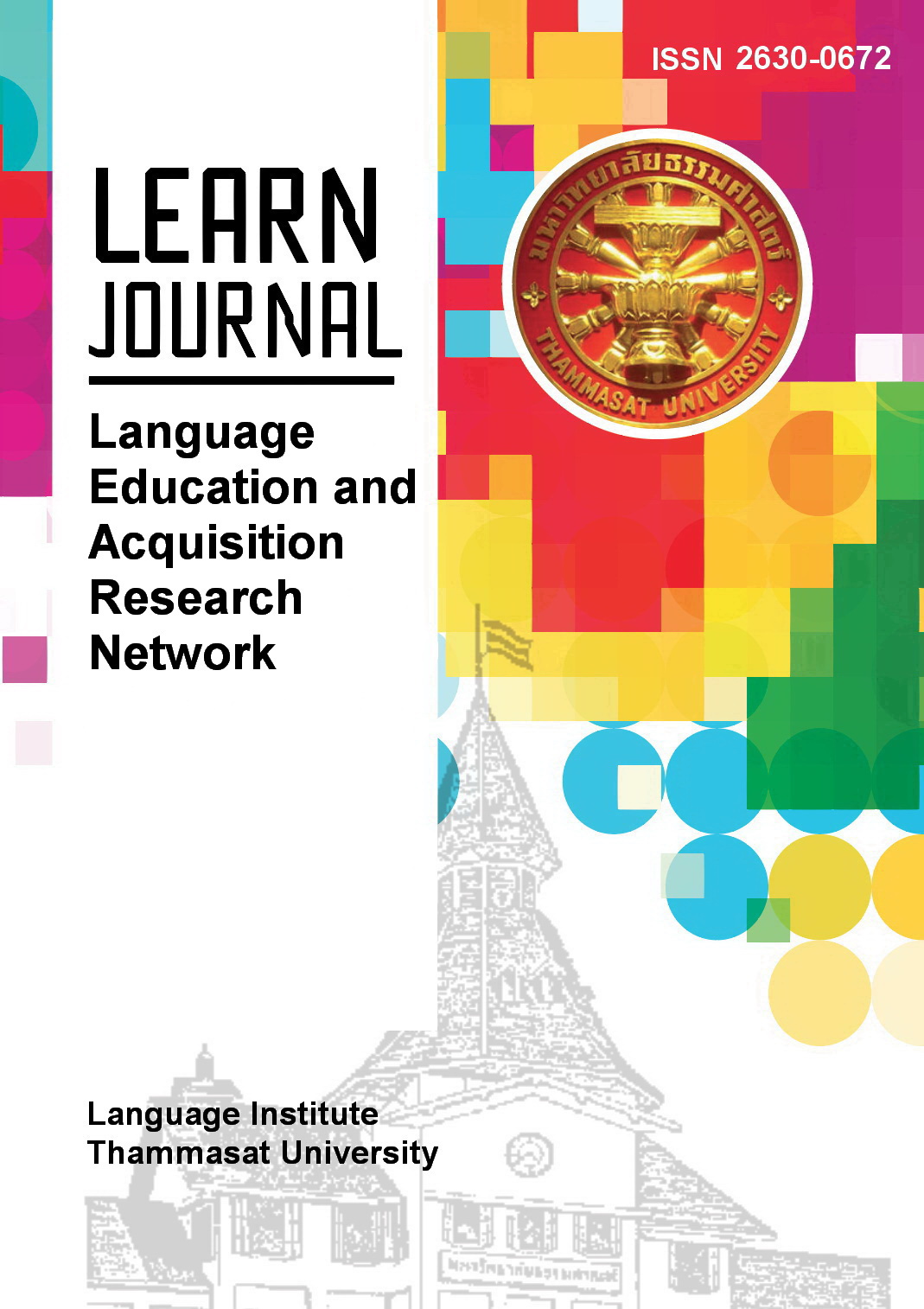Metaphorical Concepts of the Current Education System in Thailand
Main Article Content
Abstract
The present study draws upon Conceptual Metaphor Theory, its findings revealing the core concepts of the current education system in Thailand. The data is gathered from fourteen handbooks concerning quality assurance in education published on the website of the Bureau of Higher Education Standards and Evaluation, Office of the Higher Education Commission and the Education Criteria for Performance Excellence; website of Ministry of Higher Education, Research and Innovation. The results show that students are metaphorically understood as customers, products, business persons, resources, and engines; instructors as engines and artisans; and academic institutions as service industry organizations, producers, engines, depositories of wisdom, and combat units. The engine metaphor is found in every element of the education system, reflecting the fact that the Thai education system tries its best to develop people in order to ensure they can remain up-to-date with contemporary trends and function effectively in a highly competitive global environment. Moreover, the study sheds light on the effects of the “student-as-customer” metaphor, one which may cause a deterioration in students’ creativity and enthusiasm as well as in the quality of student-instructor relationships.
Article Details
References
Botha, E. (2009). Why metaphor matters in education. South African Journal of Education, 29, 431-444.
Goatly, A. (2000). The language of metaphors. Routledge.
Jantarakantee. E. (2014). The development of pre-service science teachers’ attitude about teacher characteristics by using case study of teacher Somporn who teaches monkeys. Silpakorn University Journal, 34(1), 161-179.
Kövecses, Z. (2010). Metaphor: A practical introduction (2nd ed.). Oxford University Press.
Lakoff, G., & Johnson, M. (1980). Metaphors we live by. Chicago University Press.
Leawwarin, U. (2013). Professional teachers. Phranakhon Rajabhat University.
Liang C. L., & Liang, G. K. (2016). The student-as-customer metaphor: A deconstruction using Foucauldian constructs. Australian Accounting, Business and Finance Journal, 10(1), 40-54.
Livni, E. (2017, September 9). The sum of your parts: The simple metaphor that’s increasingly getting in the way of scientific progress. http://qz.com/1072039/the-simple-metaphor-thats-increasingly-getting-in-the-way-of-scientific-progress/
Noyjarean, N. (2015). Who's teacher: Conceptual metaphor about teacher in Thai songs. Proceedings of the 53rd Kasetsart University annual conference: Education, economics and business administration, humanities and social sciences (pp. 933-941). Kasetsart University.
Office of the National Education Commission. (2003). National Education Act B.E. 2542 (1999) and Amendments (Second National Education Act B.E. 2545 (2002)). Pimdeekarnpim Co., Ltd.
Office of the Higher Education Commission. (2008a). Documents for the 7th national conference. http://www.mua.go.th/users/bhes/bhes2/aw7forsemi.pdf
Office of the Higher Education Commission. (2008b). Manual for the internal quality assurance for higher education institution (2nd ed.). http://www.mua.go.th/users/bhes/bhes2/QA_28_01_51/Handbook%20QA_MUA_2551.pdf
Office of the Higher Education Commission. (2009a). Education criteria for performance excellence 2009-2010. http://www.mua.go.th/users/bhes/front_home/Book%2018_02_53/The%202009_2010%20Education%20Criteria%20for%20Performance%20Excellence.pdf
Office of the Higher Education Commission. (2009b). Report on the 7th national conference. http://www.mua.go.th/users/bhes/bhes2/aw7.pdf
Office of the Higher Education Commission. (2011). Manual for the internal quality assurance for higher education institution 2010 (3rd ed.). http://www.mua.go.th/users/bhes/bhes2/QA%20MUA_54/ManualQA_MUA_February2554.pdf
Office of the Higher Education Commission. (2014). Manual for the internal quality assurance for higher education institution. http://www.mua.go.th/users/bhes/bhes2/56-12-27%20Manual%20for%20the%20Internal%20Final.pdf
Office of the Higher Education Commission. (2018). Guidelines for
teaching quality promotion of instructors in higher education.
http://www.mua.go.th/users/bhes/pdf/PSF_Book.pdf
Pragglejaz Group. (2007). MIP: A method for identifying metaphorically used words in discourse. Metaphor and Symbol, 22(1), 1-39.
Sathtrukram. P. (2017). Teachers’ attributes based on guru’s characteristics in the attitudes of students at Ayutthaya Technical College. [Unpublished master’s thesis]. Rajamangala University of Technology Thanyaburi.
Siphai. S. (2019). The role of Thai teachers in education 4.0. Journal of Educational Measurement Mahasarakham University, 25(2), 3-14.
Sub–Commission on developing components and indicator for the internal quality assurance for higher education institution and Sub–Commission on training to promote the internal quality assurance for higher education institution. (2009). Training Program for students to promote the internal quality assurance for higher education institution. http://www.mua.go.th/users/bhes/front_home/sttraining.pdf
Sub–Commission on developing Education for Performance Excellence. (2016, April 1). Education Criteria for Performance Excellence 2015-2018. http://www.edpex.org/2016/04/edpexcriteria58-61.html
Wisanuvekin, W. (2007). Metaphors in Thai science textbooks.
[Unpublished master’s thesis]. Chulalongkorn University.


